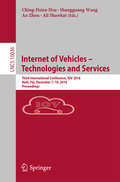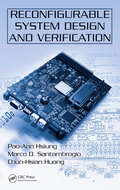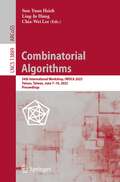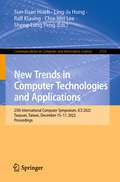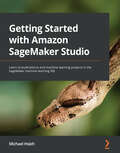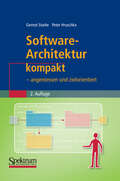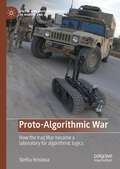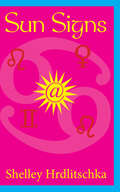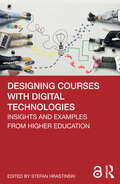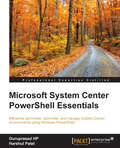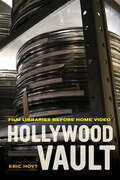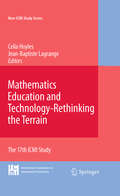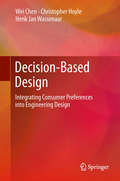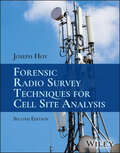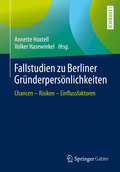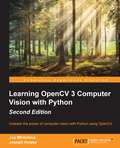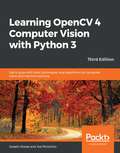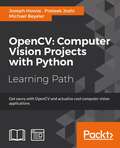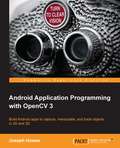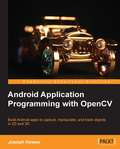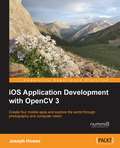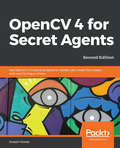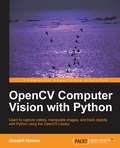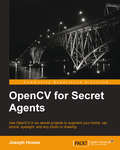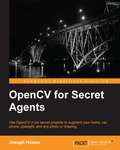- Table View
- List View
Internet of Vehicles – Technologies and Services
by Ching-Hsien Hsu Shangguang Wang Ao Zhou Ali ShawkatThis book constitutes the refereed proceedings of the Third International Conference on Internet of Vehicles, IOV 2016, held in Nadi, Fiji, in December 2016. The 22 full papers presented were carefully reviewed and selected from 55 submissions. IOV 2016 is intended to play an important role for researchers and industry practitioners to exchange information regarding advancements in the state of art and practice of IOV architectures, protocols, services, and applications, as well as to identify emerging research topics and define the future directions of IOV.
Reconfigurable System Design and Verification
by Pao-Ann Hsiung Marco D. Santambrogio Chun-Hsian HuangReconfigurable systems have pervaded nearly all fields of computation and will continue to do so for the foreseeable future. Reconfigurable System Design and Verification provides a compendium of design and verification techniques for reconfigurable systems, allowing you to quickly search for a technique and determine if it is appropriate to the task at hand. It bridges the gap between the need for reconfigurable computing education and the burgeoning development of numerous different techniques in the design and verification of reconfigurable systems in various application domains. The text explains topics in such a way that they can be immediately grasped and put into practice. It starts with an overview of reconfigurable computing architectures and platforms and demonstrates how to develop reconfigurable systems. This sets up the discussion of the hardware, software, and system techniques that form the core of the text. The authors classify design and verification techniques into primary and secondary categories, allowing the appropriate ones to be easily located and compared. The techniques discussed range from system modeling and system-level design to co-simulation and formal verification. Case studies illustrating real-world applications, detailed explanations of complex algorithms, and self-explaining illustrations add depth to the presentation. Comprehensively covering all techniques related to the hardware-software design and verification of reconfigurable systems, this book provides a single source for information that otherwise would have been dispersed among the literature, making it very difficult to search, compare, and select the technique most suitable. The authors do it all for you, making it easy to find the techniques that fit your system requirements, without having to surf the net or digital libraries to find the candidate techniques and compare them yourself.
Combinatorial Algorithms: 34th International Workshop, IWOCA 2023, Tainan, Taiwan, June 7–10, 2023, Proceedings (Lecture Notes in Computer Science #13889)
by Sun-Yuan Hsieh Ling-Ju Hung Chia-Wei LeeThis book constitutes the refereed proceedings of the 34th International Workshop on Combinatorial Algorithms, IWOCA 2023, held in Tainan, Taiwan, during June 7–10, 2023. The 33 full papers included in this book were carefully reviewed and selected from 86 submissions. They were organized in topical sections as follows: algorithms and data structures; algorithmic and combinatorical aspects of cryptography and information security; algorithmic game theory and complexity of games; approximation algorithms; complexity theory; combinatorics and graph theory; combinatorial generation, enumeration and counting; combinatorial optimization; combinatorics of words; computational biology; computational geometry; decompositions and combinatorial designs; distributed and network algorithms; experimental combinatorics; fine-grained complexity; graph algorithms and modelling with graphs; graph drawing and graph labelling; network theory and temporal graphs; quantum computing and algorithms for quantum computers; online algorithms; parameterized and exact algorithms; probabilistic and randomized algorithms; and streaming algorithms.
New Trends in Computer Technologies and Applications: 25th International Computer Symposium, ICS 2022, Taoyuan, Taiwan, December 15–17, 2022, Proceedings (Communications in Computer and Information Science #1723)
by Sun-Yuan Hsieh Ling-Ju Hung Ralf Klasing Chia-Wei Lee Sheng-Lung PengThis book constitutes the refereed proceedings of the 25th International Computer Symposium on New Trends in Computer Technologies and Applications, ICS 2022, which took place in Taoyuan, Taiwan, in December 2022. ICS is one of the largest joint international IT symposia held in Taiwan. Founded in 1973, it is intended to provide a forum for researchers, educators, and professionals to exchange their discoveries and practices, and to explore future trends and applications in computer technologies. The biannual symposium offers a great opportunity to share research experiences and to discuss potential new trends in the IT industry.The 58 full papers and one invited paper presented in this volume were carefully reviewed and selected from 137 submissions. The papers have been organized in the following topical sections: Invited Paper; Algorithms, Bioinformatics, and Computation Theory; Cloud Computing and Big Data; Computer Vision and Image Processing; Cryptography and Information Security; Electronics and Information Technology; Mobile Computation and Wireless Communication; Ubiquitous Cybersecurity and Forensics.
Getting Started with Amazon SageMaker Studio: Learn to build end-to-end machine learning projects in the SageMaker machine learning IDE
by Michael HsiehBuild production-grade machine learning models with Amazon SageMaker Studio, the first integrated development environment in the cloud, using real-life machine learning examples and codeKey FeaturesUnderstand the ML lifecycle in the cloud and its development on Amazon SageMaker StudioLearn to apply SageMaker features in SageMaker Studio for ML use casesScale and operationalize the ML lifecycle effectively using SageMaker StudioBook DescriptionAmazon SageMaker Studio is the first integrated development environment (IDE) for machine learning (ML) and is designed to integrate ML workflows: data preparation, feature engineering, statistical bias detection, automated machine learning (AutoML), training, hosting, ML explainability, monitoring, and MLOps in one environment. In this book, you'll start by exploring the features available in Amazon SageMaker Studio to analyze data, develop ML models, and productionize models to meet your goals. As you progress, you will learn how these features work together to address common challenges when building ML models in production. After that, you'll understand how to effectively scale and operationalize the ML life cycle using SageMaker Studio. By the end of this book, you'll have learned ML best practices regarding Amazon SageMaker Studio, as well as being able to improve productivity in the ML development life cycle and build and deploy models easily for your ML use cases.What you will learnExplore the ML development life cycle in the cloudUnderstand SageMaker Studio features and the user interfaceBuild a dataset with clicks and host a feature store for MLTrain ML models with ease and scaleCreate ML models and solutions with little codeHost ML models in the cloud with optimal cloud resourcesEnsure optimal model performance with model monitoringApply governance and operational excellence to ML projectsWho this book is forThis book is for data scientists and machine learning engineers who are looking to become well-versed with Amazon SageMaker Studio and gain hands-on machine learning experience to handle every step in the ML lifecycle, including building data as well as training and hosting models. Although basic knowledge of machine learning and data science is necessary, no previous knowledge of SageMaker Studio and cloud experience is required.
Software-Architektur kompakt: - angemessen und zielorientiert
by Peter Hruschka Gernot StarkeSoftware Architektur kompakt gibt Ihnen alles, was Sie zu einem reibungslosen und schnellen Start in das Thema benötigen. Lernen Sie Systeme zukunftssicher, flexibel und transparent zu konstruieren. Sie finden hier sofort einsetzbare und erprobte Muster und Vorlagen zur Erstellung praxistauglicher IT-Architekturen. Das Buch liefert allen relevanten Projektbeteiligten maßgeschneiderte Antworten zu Entwurfsentscheidungen, Systemstruktur und Implementierung.
Proto-Algorithmic War: How the Iraq War became a laboratory for algorithmic logics (Social and Cultural Studies of Robots and AI)
by Stefka HristovaDuring the Iraq War, American soldiers were sent to both fight an enemy and to recover a “failed state” in pixelated camouflage uniforms, accompanied by robots, and armed with satellite maps and biometric hand-held scanners. The Iraq War, however, was no digital game: massive-scale physical death and destruction counter the vision of a clean replayable war. The military policy of the United States, and not the actual experience of war, has been rooted in the logic of digital, and nascent algorithmic technology. This logic attempted to reduce culture, society, as well as the physical body and environment into visual data that lacks cultural and historical context. This book details the emergence of a nascent algorithmic war culture in the context of the Iraq War (2003-2010) in relation to the data-driven early 20th century British Mandate for Iraq. Through a series of five inquiries into the ways in which the Iraq War attempted to and often failed to see population and territory as digital and further proto-algorithmic entities, it offers an insight into the digitization and further unmanned automaton of war. It does so through a comparative historical framework reaching back to the quantification techniques harnessed during the British Mandate for Iraq (1918-1932) in order to explicate the parallels and complicated the diversions between the numerical logics that have driven both military state-building enterprises.
Sun Signs
by Shelley HrdlitschkaUnable to attend school while she battles cancer, fifteen-year-old Kaleigh Wyse tries to complete her classes online Developing a science project on astrology, Kaleigh enlists other online learners as study participants. What starts as a collaborative and supportive project based on the scientific method, slowly becomes unwieldy and then flawed when it is apparent that all the project participants are hiding vital clues about their identities. As Kaleigh struggles with the effects of chemotherapy and radiation, she is forced to examine the assumptions she has made about others and the manner in which she presents herself to the world. Sun Signs is a compelling story that examines the danger of blind faith in an electronic age and the ease with which our identities, in the absence of traditional clues, can shift and change.
Designing Courses with Digital Technologies: Insights and Examples from Higher Education
by Stefan HrastinskiDesigning Courses with Digital Technologies offers guidance for higher education instructors integrating digital technologies into their teaching, assessment and overall support of students. Written by and for instructors from a variety of disciplines, this book presents evaluations that the contributors have implemented in real-life courses, spanning blended and distance learning, flipped classrooms, collaborative technologies, video-supported learning and beyond. Chapter authors contextualize their approaches beyond simple how-tos, exploring both the research foundations and professional experiences that have informed their use of digital tools while reflecting on their successes, challenges and ideas for future development.
Microsoft System Center PowerShell Essentials
by Guruprasad Hp Harshul PatelIf you are a Microsoft System Center administrator who manages System Center environments and utilizes the console for management, then this book is ideal for you. This book is also for System Center users who now want to learn to manage systems using PowerShell.
Hollywood Vault: Film Libraries before Home Video
by Eric HoytHollywood Vault is the story of how the business of film libraries emerged and evolved, spanning the silent era to the sale of feature libraries to television. Eric Hoyt argues that film libraries became valuable not because of the introduction of new technologies but because of the emergence and growth of new markets, and suggests that studying the history of film libraries leads to insights about their role in the contemporary digital marketplace. The history begins in the mid-1910s, when the star system and other developments enabled a market for old films that featured current stars. After the transition to films with sound, the reissue market declined but the studios used their libraries for the production of remakes and other derivatives. The turning point in the history of studio libraries occurred during the mid to late 1940s, when changes in American culture and an industry-wide recession convinced the studios to employ their libraries as profit centers through the use of theatrical reissues. In the 1950s, intermediary distributors used the growing market of television to harness libraries aggressively as foundations for cross-media expansion, a trend that continues today. By the late 1960s, the television marketplace and the exploitation of film libraries became so lucrative that they prompted conglomerates to acquire the studios. The first book to discuss film libraries as an important and often underestimated part of Hollywood history, Hollywood Vault presents a fascinating trajectory that incorporates cultural, legal, and industrial history.
Mathematics Education and Technology-Rethinking the Terrain
by Celia Hoyles Jean-Baptiste LagrangeMathematics Education and Technology-Rethinking the Terrain revisits the important 1985 ICMI Study on the influence of computers and informatics on mathematics and its teaching. The focus of this book, resulting from the seventeenth Study led by ICMI, is the use of digital technologies in mathematics teaching and learning in countries across the world. Specifically, it focuses on cultural diversity and how this diversity impinges on the use of digital technologies in mathematics teaching and learning. Within this focus, themes such as mathematics and mathematical practices; learning and assessing mathematics with and through digital technologies; teachers and teaching; design of learning environments and curricula; implementation of curricula and classroom practice; access, equity and socio-cultural issues; and connectivity and virtual networks for learning, serve to organize the study and bring it coherence. Providing a state-of-the-art view of the domain with regards to research, innovating practices and technological development, Mathematics Education and Technology-Rethinking the Terrain is of interest to researchers and all those interested in the role that digital technology plays in mathematics education.
Decision-Based Design
by Christopher Hoyle Henk Jan Wassenaar Wei ChenBuilding upon the fundamental principles of decision theory, Decision-Based Design: Integrating Consumer Preferences into Engineering Design presents an analytical approach to enterprise-driven Decision-Based Design (DBD) as a rigorous framework for decision making in engineering design. Once the related fundamentals of decision theory, economic analysis, and econometrics modelling are established, the remaining chapters describe the entire process, the associated analytical techniques, and the design case studies for integrating consumer preference modeling into the enterprise-driven DBD framework. Methods for identifying key attributes, optimal design of human appraisal experiments, data collection, data analysis, and demand model estimation are presented and illustrated using engineering design case studies. The scope of the chapters also provides: A rigorous framework of integrating the interests from both producer and consumers in engineering design, Analytical techniques of consumer choice modelling to forecast the impact of engineering decisions, Methods for synthesizing business and engineering models in multidisciplinary design environments, and Examples of effective application of Decision-Based Design supported by case studies. No matter whether you are an engineer facing decisions in consumer related product design, an instructor or student of engineering design, or a researcher exploring the role of decision making and consumer choice modelling in design, Decision-Based Design: Integrating Consumer Preferences into Engineering Design provides a reliable reference over a range of key topics.
Forensic Radio Survey Techniques for Cell Site Analysis
by Joseph HoyFORENSIC RADIO SURVEY TECHNIQUES FOR CELL SITE ANALYSIS Overview of the end-to-end process of planning, undertaking, and reporting of forensic radio surveying to support cell site analysis The newly updated and revised Second Edition of Forensic Radio Survey Techniques for Cell Site Analysis provides an overview of the end-to-end process of planning, undertaking, and reporting of forensic radio surveying to support the forensic discipline of cell site analysis. It starts by recapping and explaining, in an accessible way, the theory, structure, and operation of cellular communications networks, then moves on to describe the techniques and devices employed to undertake forensic radio surveys. Worked examples are used throughout to demonstrate the practical steps required to plan and undertake forensic radio surveys, including the methods used to analyze radio survey data and compile it into a court report. A summary section condenses the technical and practical elements of the book into a handy reference resource for busy practitioners. The Second Edition contains 25% brand new material covering 5G New Radio networks and ‘6G and beyond,’ critical communications, mobile satellite communications, IoT networks, Cell Site Analysis Tools, and much more. Other sample topics covered in Forensic Radio Survey Techniques for Cell Site Analysis include: Radio theory, covering RF propagation, basic terminology, propagation modes, multipath transmission, and carrying information on a radio signal Core networks, including 2G, 3G, 4G, and 5G, subscriber and device identifiers, and international and temporary mobile subscriber identities Cell access control, covering cell barring, forbidden LAC/TAC, location updating, inter- and intra-carrier handovers, and 3GPP network types Forensic radio surveys objectives, terminology, and types, along with location, static spot, and indoor surveys The Second Edition of Forensic Radio Survey Techniques for Cell Site Analysis is an essential reference on the subject for police analysts, practitioners, technicians, investigators, and cell site experts, along with legal professionals and students/trainees in digital forensics.
Fallstudien zu Berliner Gründerpersönlichkeiten: Chancen – Risiken – Einflussfaktoren
by Annette Hoxtell Volker HasewinkelDieses Lehrbuch beschäftigt sich mit Gründerinnen und Gründern in verschiedenen Berliner Branchen mit ganz unterschiedlichen Lebensläufen und Hintergründen. Sie gründen alleine oder im Team, wollen reich werden oder die Welt verbessern und sind finanziell mehr oder weniger erfolgreich. Was sie verbindet, sind Risikobereitschaft, Engagement und Verantwortung: Sie sehen und ergreifen Chancen und nehmen dabei Risiken in Kauf, sie engagieren sich für ihre Idee und ihre Kunden und sie übernehmen Verantwortung für das eigene Tun, die Mitarbeiter und das eigene Unternehmen. Die vorgestellten Persönlichkeiten können Vorbilder für künftige Gründerinnen und Gründer sein, sie sind ein wesentlicher Teil der Wirtschaft und der Gesellschaft, sie schaffen Arbeitsplätze und sie zahlen Steuern. Die Autorinnen und Autoren der Fallstudien gehen der Frage nach, weshalb die jeweilige Persönlichkeit ihr Unternehmen gründete. Sie beleuchten Erfolge und Schwierigkeiten bis hin zum Scheitern und prüfen, ob es größere Zusammenhänge gibt, die eine Gründung beeinflussen. Die Fallstudien sollen einen Beitrag zur Forschung leisten und dazu anregen, aus den Geschichten der portraitierten Menschen zu lernen. Die Fallstudien eignen sich sowohl für den Einsatz in Lehrveranstaltungen als auch zum Selbststudium oder als inspirierende Lektüre für Menschen, die abwägen, ob und unter welchen Bedingungen eine Gründung für sie in Betracht kommt. Auch bereits Selbständige können durch die Beschäftigung mit den Fallstudien ihre eigene Tätigkeit reflektieren und Anregungen erhalten.
Learning OpenCV 3 Computer Vision with Python - Second Edition
by Joseph Howse Joe MinichinoUnleash the power of computer vision with Python using OpenCV About This Book * Create impressive applications with OpenCV and Python * Familiarize yourself with advanced machine learning concepts * Harness the power of computer vision with this easy-to-follow guide Who This Book Is For Intended for novices to the world of OpenCV and computer vision, as well as OpenCV veterans that want to learn about what's new in OpenCV 3, this book is useful as a reference for experts and a training manual for beginners, or for anybody who wants to familiarize themselves with the concepts of object classification and detection in simple and understandable terms. Basic knowledge about Python and programming concepts is required, although the book has an easy learning curve both from a theoretical and coding point of view. What You Will Learn * Install and familiarize yourself with OpenCV 3's Python API * Grasp the basics of image processing and video analysis * Identify and recognize objects in images and videos * Detect and recognize faces using OpenCV * Train and use your own object classifiers * Learn about machine learning concepts in a computer vision context * Work with artificial neural networks using OpenCV * Develop your own computer vision real-life application In Detail OpenCV 3 is a state-of-the-art computer vision library that allows a great variety of image and video processing operations. Some of the more spectacular and futuristic features such as face recognition or object tracking are easily achievable with OpenCV 3. Learning the basic concepts behind computer vision algorithms, models, and OpenCV's API will enable the development of all sorts of real-world applications, including security and surveillance. Starting with basic image processing operations, the book will take you through to advanced computer vision concepts. Computer vision is a rapidly evolving science whose applications in the real world are exploding, so this book will appeal to computer vision novices as well as experts of the subject wanting to learn the brand new OpenCV 3.0.0. You will build a theoretical foundation of image processing and video analysis, and progress to the concepts of classification through machine learning, acquiring the technical know-how that will allow you to create and use object detectors and classifiers, and even track objects in movies or video camera feeds. Finally, the journey will end in the world of artificial neural networks, along with the development of a hand-written digits recognition application. Style and approach This book is a comprehensive guide to the brand new OpenCV 3 with Python to develop real-life computer vision applications.
Learning OpenCV 4 Computer Vision with Python 3: Get to grips with tools, techniques, and algorithms for computer vision and machine learning, 3rd Edition
by Joseph Howse Joe MinichinoUpdated for OpenCV 4 and Python 3, this book covers the latest on depth cameras, 3D tracking, augmented reality, and deep neural networks, helping you solve real-world computer vision problems with practical code Key Features Build powerful computer vision applications in concise code with OpenCV 4 and Python 3 Learn the fundamental concepts of image processing, object classification, and 2D and 3D tracking Train, use, and understand machine learning models such as Support Vector Machines (SVMs) and neural networks Book Description Computer vision is a rapidly evolving science, encompassing diverse applications and techniques. This book will not only help those who are getting started with computer vision but also experts in the domain. You'll be able to put theory into practice by building apps with OpenCV 4 and Python 3. You'll start by understanding OpenCV 4 and how to set it up with Python 3 on various platforms. Next, you'll learn how to perform basic operations such as reading, writing, manipulating, and displaying still images, videos, and camera feeds. From taking you through image processing, video analysis, and depth estimation and segmentation, to helping you gain practice by building a GUI app, this book ensures you'll have opportunities for hands-on activities. Next, you'll tackle two popular challenges: face detection and face recognition. You'll also learn about object classification and machine learning concepts, which will enable you to create and use object detectors and classifiers, and even track objects in movies or video camera feed. Later, you'll develop your skills in 3D tracking and augmented reality. Finally, you'll cover ANNs and DNNs, learning how to develop apps for recognizing handwritten digits and classifying a person's gender and age. By the end of this book, you'll have the skills you need to execute real-world computer vision projects. What you will learn Install and familiarize yourself with OpenCV 4's Python 3 bindings Understand image processing and video analysis basics Use a depth camera to distinguish foreground and background regions Detect and identify objects, and track their motion in videos Train and use your own models to match images and classify objects Detect and recognize faces, and classify their gender and age Build an augmented reality application to track an image in 3D Work with machine learning models, including SVMs, artificial neural networks (ANNs), and deep neural networks (DNNs) Who this book is for If you are interested in learning computer vision, machine learning, and OpenCV in the context of practical real-world applications, then this book is for you. This OpenCV book will also be useful for anyone getting started with computer vision as well as experts who want to stay up-to-date with OpenCV 4 and Python 3. Although no prior knowledge of image processing, computer vision or machine learning is required, familiarity with basic Python programming is a must.
OpenCV: Computer Vision Projects with Python
by Joseph Howse Prateek Joshi Michael Beyeler<P><P>About This Book <P><P>Use OpenCV's Python bindings to capture video, manipulate images, and track objects <P><P>Learn about the different functions of OpenCV and their actual implementations. <P><P>Develop a series of intermediate to advanced projects using OpenCV and Python <P><P>Who This Book Is For <P><P>This learning path is for someone who has a working knowledge of Python and wants to try out OpenCV. This Learning Path will take you from a beginner to an expert in computer vision applications using OpenCV. OpenCV's application are humongous and this Learning Path is the best resource to get yourself acquainted thoroughly with OpenCV. <P><P>What You Will Learn <P><P>Install OpenCV and related software such as Python, NumPy, SciPy, OpenNI, and SensorKinect - all on Windows, Mac or Ubuntu <P><P>Apply "curves" and other color transformations to simulate the look of old photos, movies, or video games <P><P>Apply geometric transformations to images, perform image filtering, and convert an image into a cartoon-like image <P><P>Recognize hand gestures in real time and perform hand-shape analysis based on the output of a Microsoft Kinect sensor <P><P>Reconstruct a 3D real-world scene from 2D camera motion and common camera reprojection techniques <P><P>Detect and recognize street signs using a cascade classifier and support vector machines (SVMs) <P><P>Identify emotional expressions in human faces using convolutional neural networks (CNNs) and SVMs <P><P>Strengthen your OpenCV2 skills and learn how to use new OpenCV3 features <P><P>In Detail <P><P>OpenCV is a state-of-art computer vision library that allows a great variety of image and video processing operations. OpenCV for Python enables us to run computer vision algorithms in real time. This learning path proposes to teach the following topics. First, we will learn how to get started with OpenCV and OpenCV3's Python API, and develop a computer vision application that tracks body parts. Then, we will build amazing intermediate-level computer vision applications such as making an object disappear from an image, identifying different shapes, reconstructing a 3D map from images , and building an augmented reality application, Finally, we'll move to more advanced projects such as hand gesture recognition, tracking visually salient objects, as well as recognizing traffic signs and emotions on faces using support vector machines and multi-layer perceptrons respectively. <P><P>This Learning Path combines some of the best that Packt has to offer in one complete, curated package. It includes content from the following Packt products:
Android Application Programming with OpenCV
by Joseph HowseA step-by-step tutorial to help you master computer vision and mobile app development.This book is for Java developers who are new to computer vision and who would like to learn about how it is used in relation to application development. It is assumed that you have previous experience in Java, but not necessarily Android. A basic understanding of image data (for example pixels and color channels) would be helpful too. You are expected to have a mobile device running Android 2.2 (Froyo) or greater and it must have a camera.
Android Application Programming with OpenCV
by Joseph HowseA step-by-step tutorial to help you master computer vision and mobile app development.This book is for Java developers who are new to computer vision and who would like to learn about how it is used in relation to application development. It is assumed that you have previous experience in Java, but not necessarily Android. A basic understanding of image data (for example pixels and color channels) would be helpful too. You are expected to have a mobile device running Android 2.2 (Froyo) or greater and it must have a camera
iOS Application Development with OpenCV 3
by Joseph HowseCreate four mobile apps and explore the world through photography and computer vision About This Book * Efficiently harness iOS and OpenCV to capture and process high-quality images at high speed * Develop photographic apps and augmented reality apps quickly and easily * Detect, recognize, and morph faces and objects Who This Book Is For If you want to do computational photography and computer vision on Apple's mobile devices, then this book is for you. No previous experience with app development or OpenCV is required. However, basic knowledge of C++ or Objective-C is recommended. What You Will Learn * Use Xcode and Interface Builder to develop iOS apps * Obtain OpenCV's standard modules and build extra modules from source * Control all the parameters of the iOS device's camera * Capture, save, and share photos and videos * Analyze colors, shapes, and textures in ordinary and specialized photographs * Blend and compare images to create special photographic effects and augmented reality tools * Detect faces and morph facial features * Classify coins and other objects In Detail iOS Application Development with OpenCV 3 enables you to turn your smartphone camera into an advanced tool for photography and computer vision. Using the highly optimized OpenCV library, you will process high-resolution images in real time. You will locate and classify objects, and create models of their geometry. As you develop photo and augmented reality apps, you will gain a general understanding of iOS frameworks and developer tools, plus a deeper understanding of the camera and image APIs. After completing the book's four projects, you will be a well-rounded iOS developer with valuable experience in OpenCV. Style and approach The book is practical, creative, and precise. It shows you the steps to create and customize five projects that solve important problems for beginners in mobile app development and computer vision. Complete source code and numerous visual aids are included in each chapter. Experimentation is an important part of the book. You will use computer vision to explore the real world, and then you will refine the projects based on your findings.
OpenCV 4 for Secret Agents: Use OpenCV 4 in secret projects to classify cats, reveal the unseen, and react to rogue drivers, 2nd Edition
by Joseph HowseTurn futuristic ideas about computer vision and machine learning into demonstrations that are both functional and entertainingKey FeaturesBuild OpenCV 4 apps with Python 2 and 3 on desktops and Raspberry Pi, Java on Android, and C# in UnityDetect, classify, recognize, and measure real-world objects in real-timeWork with images from diverse sources, including the web, research datasets, and various camerasBook DescriptionOpenCV 4 is a collection of image processing functions and computer vision algorithms. It is open source, supports many programming languages and platforms, and is fast enough for many real-time applications. With this handy library, you’ll be able to build a variety of impressive gadgets.OpenCV 4 for Secret Agents features a broad selection of projects based on computer vision, machine learning, and several application frameworks. To enable you to build apps for diverse desktop systems and Raspberry Pi, the book supports multiple Python versions, from 2.7 to 3.7. For Android app development, the book also supports Java in Android Studio, and C# in the Unity game engine. Taking inspiration from the world of James Bond, this book will add a touch of adventure and computer vision to your daily routine. You’ll be able to protect your home and car with intelligent camera systems that analyze obstacles, people, and even cats. In addition to this, you’ll also learn how to train a search engine to praise or criticize the images that it finds, and build a mobile app that speaks to you and responds to your body language.By the end of this book, you will be equipped with the knowledge you need to advance your skills as an app developer and a computer vision specialist.What you will learnDetect motion and recognize gestures to control a smartphone gameDetect car headlights and estimate their distanceDetect and recognize human and cat faces to trigger an alarmAmplify motion in a real-time video to show heartbeats and breathsMake a physics simulation that detects shapes in a real-world drawingBuild OpenCV 4 projects in Python 3 for desktops and Raspberry PiDevelop OpenCV 4 Android applications in Android Studio and UnityWho this book is forIf you are an experienced software developer who is new to computer vision or machine learning, and wants to study these topics through creative projects, then this book is for you. The book will also help existing OpenCV users who want upgrade their projects to OpenCV 4 and new versions of other libraries, languages, tools, and operating systems. General familiarity with object-oriented programming, application development, and usage of operating systems (OS), developer tools, and the command line is required.
OpenCV Computer Vision with Python
by Joseph HowseA practical, project-based tutorial for Python developers and hobbyists who want to get started with computer vision with OpenCV and Python.OpenCV Computer Vision with Python is written for Python developers who are new to computer vision and want a practical guide to teach them the essentials. Some understanding of image data (for example, pixels and color channels) would be beneficial. At a minimum you will need access to at least one webcam. Certain exercises require additional hardware like a second webcam, a Microsoft Kinect or an OpenNI-compliant depth sensor such as the Asus Xtion PRO.
OpenCV for Secret Agents
by Joseph HowseThis book is for programmers who want to expand their skills by building fun, smart, and useful systems with OpenCV. The projects are ideal in helping you to think creatively about the uses of computer vision, natural user interfaces, and ubiquitous computers (in your home, car, and hand).
OpenCV for Secret Agents
by Joseph Howse<P><P>Use OpenCV in six secret projects to augment your home, car, phone, eyesight, and any photo or drawing <P><P>About This Book <P><P>Build OpenCV apps for the desktop, the Raspberry Pi, Android, and the Unity game engine <P><P>Learn real-time techniques that can be used to classify images, detecting and recognizing any person or animal, and studying motion and distance with superhuman precision <P><P>Design hands-free interfaces that are practical in home automation, in cars, and in discrete surveillance <P><P>Who This Book Is For <P><P>This book is for programmers who want to expand their skills by building fun, smart, and useful systems with OpenCV. The projects are ideal in helping you to think creatively about the uses of computer vision, natural user interfaces, and ubiquitous computers (in your home, car, and hand). <P><P>What You Will Learn <P><P>Install OpenCV, a Python development environment, and an Android development environment on Windows, Mac, or Linux and install a Unity development environment on Windows or Mac <P><P>Get to grips with motion detection and gesture recognition as a means of controlling a guessing game on a smartphone <P><P>Detect car headlights, estimate distances to them, and provide feedback to the driver <P><P>Spot and recognize human faces and cat faces as a means of controlling an alarm <P><P>Amplify motion in real-time video so that a person's heartbeat and breathing become clearly visible <P><P>Draw a ball-in-a-maze puzzle on paper and see it come to life as a physics simulation on a smartphone <P><P>Integrate OpenCV with other libraries, as well as popular frameworks for GUI apps and games <P><P>In Detail <P><P>OpenCV is a grand collection of image processing functions and computer vision algorithms. It is open source, it supports many programming languages and platforms, and it is fast enough for many real-time applications. What a lot of gadgets we can build with such a handy library! <P><P>Taking inspiration from the world of James Bond, this book adds a spark of adventure and computer vision to your daily routine. Protect your home and car with intelligent camera systems that analyze people, cats, and obstacles. Let your search engine praise or criticize the images that it finds. Hear a voice from your phone that responds to your body language. Attune yourself to another person's rhythm by glancing at a display that magnifies a heartbeat or a breath. Learn OpenCV and see your world as never before.
